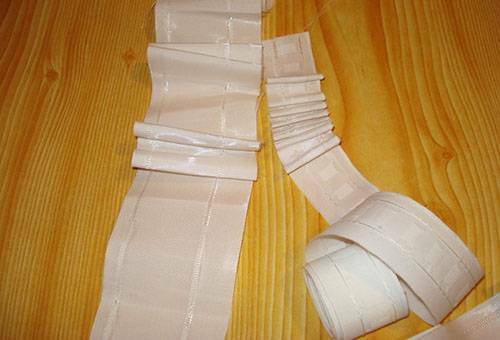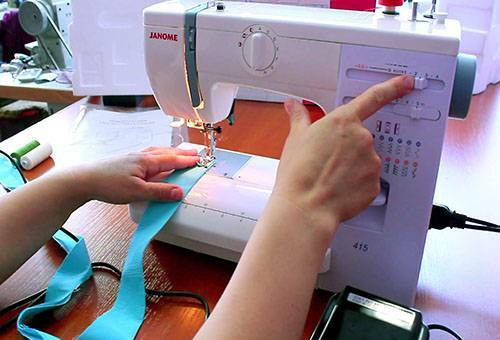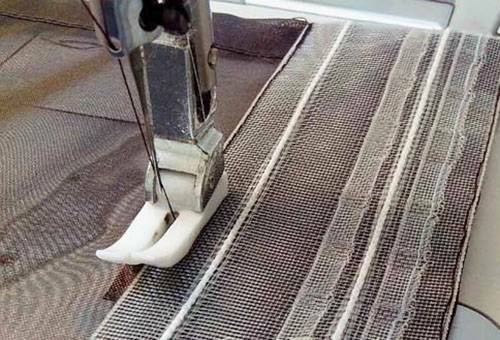Contents:
- How much and what braid should I buy?
- Set up the sewing machine
- Sewing the tape
To refresh the interior, it is not necessary to start a full-scale repair or replacement of furniture. Decorating with new textiles - curtains and curtains - will help to give completely different accents to any room. Many housewives, buying a new fabric for window draping, prefer to decorate them independently, including sewing a special tape. To do this correctly, you need:
- calculate the length of the curtain tape;
- adjust the sewing machine to suit the density of the curtains;
- sew the braid without planting.
And if the first two steps are easy to perform, then the third - the right seam - involves having experience in the sewing business. Therefore, before sewing yourself curtains from expensive fabrics, it is desirable to practice on a simpler tulle, taking into account the tips set out below.

How much and what braid should I buy?
The calculation of the length of the curtain tape depends on two parameters: the width of the window opening and the type of the braid itself. The type of braid is taken into account when buying curtains, since it will depend on this, how much it will collect and what the width will be as a result. There are many styles of assembly: cylindrical, uniform, triple, bow, "buff", "butterfly" and others. To understand what kind of fold is obtained as a result, you do not need to know all the names. It's enough just to pull the ribbon - and the drawing of the assembly will immediately manifest itself. Similarly, it will look and on the curtain.
When choosing the type of assembly, you need to take into account its coefficient. It can be 1: 1.5, 1: 2, 1: 2.5 or 1: 3.If the first number is taken as 1 meter, the second will indicate how much tissue is needed to close 1 meter of the window opening. For example, buying a curtain tape with a bow fold and a ratio of 1: 3 per window of three meters in width, you need to purchase 9 meters of tulle and the same amount of braid.
If the curtains are already bought, then you need to choose a braid with a suitable coefficient. To do this, you need to divide the width of the fabric into the width of the opening. For example, if you have a curtain 4 meters wide and a window aperture is 2, then you need 4 divided by 2. As a result, you get 2, which means the ratio should be 1: 2.
Advice
Counting the length of the braid and the width of the curtains, take into account not only the opening itself, but also the space near it, which is supposed to be closed. In addition, it should be borne in mind that some fabrics stretch slightly when sewing, so braids need to be bought 10-15 cm more than the estimated length.
In addition to the coefficient and assembly type, the tape differs according to the following parameters:
- width,
- density,
- transparency,
- the number of levels for hooks.
For curtains - tulle, organza - for curtains of light, translucent fabric transparent tape is suitable. Than it will be wider, the more effective the assembly after sewing will look. Opposite, opaque is suitable only for dense fabrics.

Set up the sewing machine
To properly adjust the sewing machine, it is advisable to use a piece of the same material on which the tape will be sewn and the threads to be used in the work. Folding the fabric in half, you need to make a trial line and see the result. If the seam is smooth, no loops are seen from either side, and the fabric is not attached, additional adjustment is not needed - you can start working. Otherwise, you need to adjust the tension of the threads or the degree of pressing the presser foot.
If the fabric is pulled out when stuck, this may indicate excessive or insufficient pressure of the presser foot on the fabric. Most often, this problem occurs if thin tissues such as organza are used. To eliminate the trouble, you need to set the adjustment lever to the desired position. For tulle it is set to "1", for thick curtains - "3".
Too loose a seam with tangled threads on the bottom of the fabric indicates that the upper thread tension is too weak. In this case, tighten the tensioner. If the nodules are visible on the upper seam, adjust the same tensioner, but weaken it already. The tensioner on the bobbin( lower thread) can not be touched. It can be adjusted only by a master or a person with great experience.
Advice to
Beginners in the sewing business will find it easier to understand what the problem is if you use threads of different colors, different from the color of the fabric. Then the ready-made seam will show which thread is "problematic".

Sewing the tape
After setting up the machine, you can start working. If threads of different colors were used for the trial joint, they must be changed. To sew the curtains, the threads in the same tone as the curtains themselves are ideal. But in their absence, you should not be upset either, you can pick up any that are close in tone. The main thing is that they are not lighter than the fabric. The thread number is selected according to the type of fabric, and according to the threads a needle is exposed.
| Fabric type | Thread number | Thread number | Needle number |
| Heavy linen fabric | 20 | 100-120 | |
| Heavyweight cotton fabric | 30 or 40 | 95 or 100 | |
| Heavy synthetic fabric | 40 | 95 | |
| Heavy silk | 50 | 85 or 90 | |
| Slim cotton | 50 or 60 | 70-90 | |
| Tulle | 60 | 60-65 | |
| Organza | 60 or 80 | 60-65 |
After threading, in order to properly sew the tape, you need to perform the actions in a certain sequence.
- On the underside of the fabric, a bend of 1.5-2 cm is made and pressed.
- On the prepared fabric put the tape( on the wrong side) so that it is not visible from the front side. That is, it should be sewn on 0.3-0.5 cm below the edge of the fabric. If you want the curtain to cover the cornice, then the tape falls even lower. The edges of the tape are left at the edges, and the cords are fixed with a knot so that they do not "run away."
- You can further sweep the ribbon and tulle, and if you already have experience in sewing things, you can do without this step. Instead, you can pin the ribbon with sewing pins.
- The next step is to stitch the top seam. It should be located a few millimeters below the edge of the braid. In the process of steeping, you need to make sure that the fabric does not stretch and does not frown.
- After this, the pins must be cut through the bottom seam - a few millimeters above the edge of the tape.
- When sewing the bottom seam, care must be taken to ensure that it is not planted. It is for this to pin pins - they serve as a guide and in time will show that the fabric, stretching, "pulls out."To prevent this from happening, you must evenly feed the tape and cloth under the needle.
- The final step is the wrapping of the edge of the tape. If the fabric does not stretch, and the stock of the tape remains, it is cut off. The edges of the tape should be tucked and sew on the side seam of tulle or curtains.

After all the sewing operations are completed, the cords are pulled together. As a result, the ends of the cords hang almost along the entire length of the curtains. Cut them undesirable: when washing, they blossom, so that dirt is not collected in wrinkles. In addition, if circumstances suddenly develop so that you have to outweigh the curtains to another, wider, window, the coupler will have to be weakened, and the length of the cords will then not be enough. A good way out is to sew sacks for cords around the edges of curtains from curtain fabric or from a piece of tape. Another option - to wrap the cords on pieces of thick paper and pinned to the braid.



